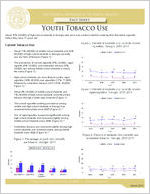DE TH
OF PU
PARTMENT BLIC HEAL
The Georgia Department Of Public Health Fact Sheet
Youth Tobacco Use
About 10% (20,000) of high school students in Georgia who have ever smoked admit to smoking their first whole cigarette before they were 11 years old.1
Current Tobacco Use
About 11% (38,000) of middle school students and 23% (93,000) of high school students in Georgia currently use any form of tobacco (Figure 1).2
The prevalence of current cigarette (6%; 23,000), cigar/ cigarillo (6%; 23,000), and smokeless tobacco (5%; 18,000) use among middle school students is nearly the same (Figure 1).2
High school students are more likely to smoke cigar/ cigarillos (18%; 82,000) and cigarettes (17%; 71,000), followed by smokeless tobacco (SLT) (10%; 43,000) Figure 1).2
About 4% (16,000) of middle school students and 7% (30,000) of high school students currently smoke tobacco through a water pipe (hookah) (Figure 1).1
The overall cigarette smoking prevalence among middle and high school students in Georgia has remained fairly stable since 2005 (Figure 2).2,3
Use of cigar/cigarillos increased significantly among high school students and increased slightly among middle school students since 2009 (Figure 3).2,3
Smokeless tobacco use increased slightly among high school students and remained stable among middle students since 2009 (Figure 4).2,3
2 Peachtree Street, Atlanta, Ga 30303 w www.dph.ga.gov
March 2012
Youth Tobacco Use
Current Tobacco Use by Demographics
The prevalence of current cigarette smoking among male (7%; 12,000) and female (6%; 11,000) middle school students was similar (Figure 5).2
Male (19%; 39,000) high school students were more
likely to smoke than female high school students (15%; 31,000) (Figure 5).2
Smoking was higher among non-Hispanic white (9%; 14,000) and Hispanic (9%; 3,000) middle school students, followed by non-Hispanic black (3%; 4,000) middle school students (Figure 6).2
Non-Hispanic white (24%; 46,000) high school students had the highest smoking prevalence, followed by Hispanic (17%; 6,000) and non-Hispanic black (8%; 13,000) high school students (Figure 6).2
Prevalence of cigarette smoking generally increased with grade level and was significantly higher among 12th graders at 25% (21,000) (Figure 7).2
Youth Tobacco Use
Miscellaneous
Youth cigarette smoking on middle (MS) and high (HS) school property has declined since 2005, however, use of smokeless tobacco (SLT) on school property is increasing (Figures 8 and 9).1,4
In the past 30 days, about 60% (4,000) of current middle school smokers and about 51% (12,000) of current high school smokers under age 18 who bought cigarettes in a store reported that they were not asked to show proof of age.1
About 49% (33,000) of high school students who currently smoke cigarettes tried to quit during the past year.2
Secondhand Smoke Exposure and Asthma
About 45% (162,000) of middle school students and 55% (248,000) of high school students were exposed to secondhand smoke in the past seven days.1
Exposure to secondhand smoke varied by race/ ethnicity with NH white students being more likely to have exposure (Figure 10).1
Approximately 48% (42,000) of middle school students and 54% (62,000) of high school students who have ever been diagnosed with asthma were exposed to secondhand smoke in the past seven days.1
Definition of Terms
1. Current smoker: Youth who has smoked at least one cigarette in the past 30 days
2. Smokeless Tobacco (SLT): Includes chewing tobacco, snuff, or dip
3. Cigarillos: Little cigars 4. Any tobacco: Includes cigarettes, cigars/cigarillos, and
smokeless tobacco 5. Secondhand smoke: Smoke emitted from the end of a
burning cigarette, cigar, or pipe 6. Secondhand smoke exposure: Rode in a car or was in
the same room with someone who smoked for at least one of the past seven days
Data sources: 1. 2011 Georgia Youth Tobacco Survey (YTS) 2. 2011 Georgia Youth Risk Behavior Survey (YRBS) 3. 2003, 2005, 2007, & 2009 Georgia Youth Risk Behavior Survey (YRBS) 4. 2005 Georgia Youth Tobacco Survey Report (http://www.health.state.ga.us/epi/cdiee/tobaccouse.asp)
Visit http://health.state.ga.us/publications/datasummaries.asp for more information about tobacco use in Georgia Visit http://health.state.ga.us/programs/tobacco/index.asp for more information about the Georgia Tobacco Use Prevention Program
Youth Tobacco Use
QUITTING TAKES PRACTICE! The Georgia Tobacco Quit Line is available for all Georgians 13 years of age and older who want to quit using tobacco. To receive free counseling, support, and referral services call:
1-877-270-STOP (English)
1-877-2NO-FUME (Spanish)
1-877-777-6534 (Hearing Impaired)
www.livehealthygeorgia.org/quitLine/index.shtml
Georgia Smokefree Air Act of 2005
A smokefree public place must prohibit smoking twenty-four hours per day and post the appropriate signage noting the state health code for the Georgia Smokefree Air Act of 2005 (O.C.G.A. 31-12A-1 et seq). For more information on the law, visit our websites:
http://dhr.Georgia.gov/gasmokefreeair
www.livehealthygeorgia.org
Reduce your risk of developing chronic conditions and diseases.
Eat Healthy.
A healthy eating plan is one that emphasizes fruits, vegetables, whole grains, and fat-free or low-fat milk and mild products; includes lean meats, poultry, fish, beans, eggs, and nuts; and is low in saturated fats, trans fats, cholesterol, salt (sodium),
and added sugars.
Be active.
Participating in regular physical activity can help to reduce many risk factors associated with chronic diseases, including obesity and high blood pressure.
Be smoke free.
Quitting smoking lowers the chance of having cancer, heart attack, or stroke and improves overall health and well-being, regardless how long a person has been smoking.
Get checked.
Undergoing routine physical check-ups and screenings can prevent some chronic diseases and detect other chronic diseases earlier when treatment may be more effective.
Be positive.
A positive attitude contributes to your overall well-being.
Following these guidelines can greatly reduce the chances of developing a chronic disease, leading to an improved quality of life and reduced healthcare costs.
For more information on the Live Healthy Georgia campaign, visit www.livehealthygeorgia.org.
Georgia Department of Public Health 2 Peachtree Street, NW Atlanta, GA 30303 (404) 657-3103 ga-tobacco@dhr.state.ga.us http://health.state.ga.us
